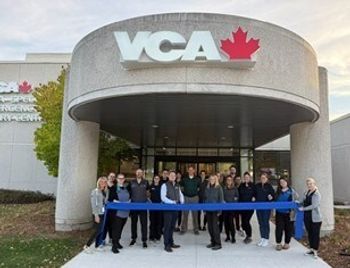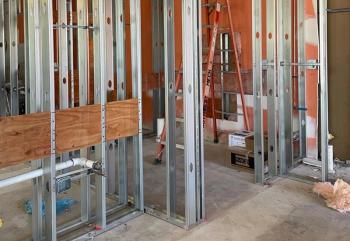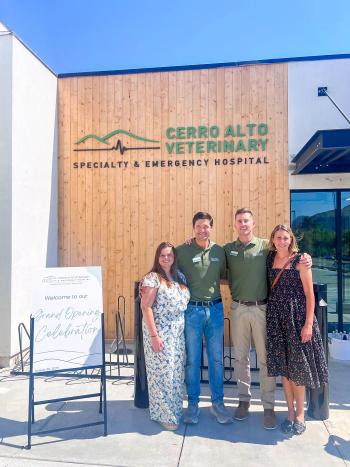
Two practices merge
How often does a knock on the door make your dream come true? Once was enough for Drs. James McGill and Linda Miller, two veterinarians who worked in separate practices north of Seattle. Despite a virtually invisible location, Dr. McGill's 2,300-square-foot leasehold was growing 30 percent each year. And Dr. Miller wanted to offer 24-hour care, but a surgical hospital rented the facility during the day. Both doctors wanted new hospitals, but the cost held them back.
By Carolyn Chapman, special assignments editor
How often does a knock on the door make your dream come true? Once was enough for Drs. James McGill and Linda Miller, two veterinarians who worked in separate practices north of Seattle. Despite a virtually invisible location, Dr. McGill's 2,300-square-foot leasehold was growing 30 percent each year. And Dr. Miller wanted to offer 24-hour care, but a surgical hospital rented the facility during the day. Both doctors wanted new hospitals, but the cost held them back.
That's when Pet's Choice Inc., a corporation that owns and operates 52 hospitals in Washington, Arizona, Texas, and Oklahoma, came knocking. Looking to build its presence in the Seattle area, Pet's Choice canvassed local practices to buy. Pet's Choice bought the emergency clinic where Dr. Miller worked in 1996. And after meeting Dr. McGill, the corporation wanted to capitalize on the doctors' proximity and growth potential. So Pet's Choice offered to build a state-of-the-art hospital on a highly visible corner lot--at no cost to the doctors. The single facility houses the two practices and offers them separate entrances but lets the hospitals enjoy new efficiencies by sharing some space and equipment.
The new facility garnered high praise from judges of Veterinary Economics' 2000 Hospital Design Competition--they liked the clean floor plan and the traffic flow through the general practice. One judge said, "This is an excellent plan that combines a general hospital and an emergency/referral center."
Combining forces
Dr. McGill, a 1972 Washington State University graduate, was considering selling the practice or hiring a partner to reduce his patient and management workload when Pet's Choice approached him. The company's interest gave him a third option. "I never could have afforded to build the kind of hospital we're in now," he says.
Now Dr. McGill serves as medical director of Alderwood Companion Animal Hospital, his original practice name, and Pet's Choice hired two associates to handle the growing client base. "Basically, I function as a sole proprietor," explains Dr. McGill. "But as part of Pet's Choice I enjoy more support and resources, including more people to share the workload."
Dr. Miller is medical director of Animal Emergency & Referral Center, which occupies the east side of the 9,300-square-foot building. "I was excited when Pet's Choice talked to me about moving into a new hospital," she says. The new facility helped the 1992 University of California-Davis graduate realize her dream of offering 24-hour care. "The only way for the practice to grow was to build a new facility, but we never would've been able to pull this off on our own."
Planning the project
Staff members at both hospitals helped make key design decisions, and Pet's Choice handled the construction, letting doctors focus on medicine. To keep the building project progressing smoothly, Pet's Choice asked Jay Phillips, then facilities director for the company and a veteran of multiple veterinary hospital design projects, to oversee construction. Phillips rejected two sites before finding the ideal corner lot.
Even more perfect: it was a build-to-suit arrangement. This meant the corporation didn't face high up-front costs to build a hospital. Instead, they could spread the payments over time. The owner paid for property improvements, and Pet's Choice pays annual rent based on 11 percent of the building costs plus 10 percent of the land value. "This arrangement would be too costly for most solo practice owners," Phillips says.
When drawing the floor plan, Phillips gave the hospitals separate entrances and joined them with a shared middle corridor that contains radiology and the dark room, storage, laundry, and isolation. The companion animal hospital offers 1.5 exam rooms per doctor and includes three wet tables, two treatment tables, and one dental table in the treatment area.
For the emergency facility, Phillips designed an open treatment room that lets the team accommodate several critical cases simultaneously. An exotics ward and 40 kennels in the treatment area help staff members monitor serious cases.
Before finalizing the design, Phillips presented the floor plan to Drs. McGill and Miller. "We made only minor alterations to the plan," says Dr. McGill. "And we visited the site only once, a couple of weeks before the move."
Step inside
Phillips chose a brick/stucco combination for the exterior of the facility, and an independent interior designer used earth-tone colors to create a unified look in both hospitals. The cat condos offer skylights and piped-in music, and a stained, sealed concrete floor brightens the kennel. "We didn't want the boarding areas to feel dreary," Phillips says.
Dr. McGill says the direct traffic flow from the exam rooms to the treatment area in Alderwood Companion Animal Hospital improves the efficiency of office visits. And a doctors' station and a reporting station in the treatment area of both hospitals give team members personal space and help create a comfortable working environment for the large staff. A large consultation room, which is becoming a common feature in new hospitals, gives team members a quiet, private place to discuss delicate cases with clients.
Phillips chose to keep the retail area for the companion animal hospital small, acknowledging the trend toward doctors focusing more on medicine than retail sales. And he prepared for the future by installing network wiring that will support a computerized medical record system.
A special opportunity
Dr. McGill believes the fears some veterinarians have about corporate practice are misplaced. "This move has been a great solution for me," he says. "The company offered me a spacious facility where I can practice medicine my own way. It retained all my staff members and added others to handle the growth. And the corporation really trusts me to make it work."
As an exclusively emergency practitioner for eight years, Dr. Miller says moving into the new hospital was a dream come true: "I always imagined offering the quality of patient care that we now provide," she says.
Carolyn Chapman, a former Veterinary Economics associate editor, is a freelance writer in Liberty, Mo.
June 2000 Veterinary Economics
Newsletter
From exam room tips to practice management insights, get trusted veterinary news delivered straight to your inbox—subscribe to dvm360.






